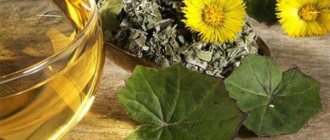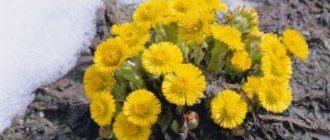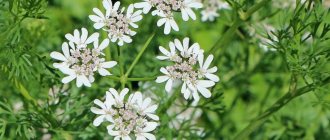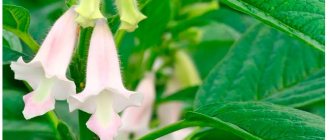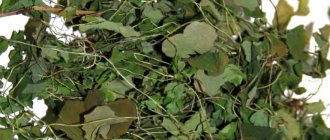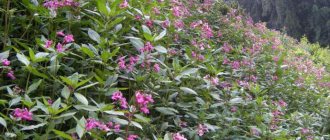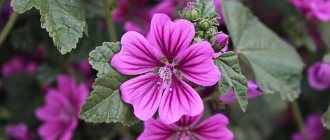It is a perennial plant of the Asteraceae family. Its only representative is the common coltsfoot. The scientific name comes from the Latin “tussis” (cough) and “aqo” (to drive away) and is translated as “cough”. In traditional and scientific medicine, the plant is used as an effective cough remedy. Popular names of the plant are king potion, two-leafed grass, camouflage grass, water burdock, mother grass, butterbur. Coltsfoot is a honey plant that provides pollen and nectar to bees.
Where does coltsfoot grow up?
The plant's homeland is Africa and North America; as an alien plant, it has also multiplied in other parts of the world. Grows on soils that lack turf - clay, sand and pebbles. In large numbers, coltsfoot can be seen in fields, landfills, embankments, wastelands, in ravines, near roads, along the banks of rivers and streams.
Coltsfoot flowers
Legends about the plant
There are a large number of legends associated with the origin of the coltsfoot. Many of them are sad in nature and end in tears.
Thus, one of the most popular tells about a woman who lost her own daughter. After the death of a loved one, she sat for a long time in the cemetery, stroking the ground with her palms and caressing the place where the child was buried. Under the influence of maternal love, a colorful flower appeared from under the ground, covering the grave with its felt side with a warm surface. But besides her deceased daughter, the woman also had a stepdaughter, to whom she did not show such love. As a result, the underside of the leaves became hard and cold.
We recommend that you check out Catnip for cats
Another legend about the coltsfoot says that in the distant past a man left his wife and daughter and went to a new woman. But he constantly maintained a relationship with his beautiful daughter with luxurious golden hair, and his new wife did not like this very much. Inflamed with jealousy, she decided to kill the child and lured him to a cliff, and then pushed him down.
When her own mother realized and noticed that her daughter was gone, she ran in search and found her dead, thrown off a cliff. In order to take revenge on the evil stepmother, she also dragged her to this cliff, but in the struggle for life, both women fell down and died. At the site of their fight, small flowers with bright yellow inflorescences formed, reminiscent of the golden curls of the deceased girl. And the underside of the leaves symbolized maternal love, and the outer surface symbolized the hatred and cruelty of the stepmother. As a result, the plant became known as coltsfoot.
There is another legend, the heroes of which are members of a happy family, where the mother suddenly dies.
The distressed children stop playing and singing songs, and the father dries up from grief. But after some time, a young neighbor comes to the house and becomes the widower’s new wife. However, it was difficult for the children to get used to their stepmother, because... she will never be able to replace her mother, and her voice emanates coldness, and any touch is accompanied by anger and cruelty.
When the spring sun appeared outside, the youngest daughter ran with her sadness to the nearest river and began to cry bitterly, remembering her mother. And at one moment she raised her head, and a beautiful yellow flower grew near her feet. After this, the neighbor, who became the children’s stepmother, disappeared without a trace, and joyful laughter appeared in the house again. From that time on, the beautiful plant began to appear every spring, checking to see if the children were doing well, and then disappearing back. In summer, in its place there were lush leaves with a cold surface on top and a warm surface below.
Another legend of Ukrainian origin has an equally interesting plot. Once upon a time, a husband and wife lived for themselves, enjoying their love and the ringing laughter of their children. But one day the woman found herself in the pouring rain, got wet and fell ill. Every day she melted like a wax candle and could no longer rise on her own. Feeling upset, she called her husband to her and said to him: “Oh, Vasily, I will die soon. Take care of the kids, take a new wife, but not the neighbor's widow, because... She already has children and she won’t love ours.”
After the funeral, Vasily began to look for a new mother for his children. And it so happened that he wooed the neighbor’s widow. However, the predictions of the deceased wife came true: the stepmother divided the children into her own and her husband. The first received all the best, but the orphans starved, wore old clothes and were sick. When winter ended, the evil woman drove her husband’s children outside to warm themselves by the river bank. But the children were freezing in torn clothes and began to cry, asking:
-Sun! Warm our heads!
Looking at the poor children, the sun decided to warm them up by placing wreaths of golden flowers on their heads. Seeing what was happening, the stepmother decided to ask the orphans where they got these beautiful wreaths from. Having learned about what had happened, the envious woman immediately sent her own children to the river bank and said: “Take the blankets, let the sun give you wreaths.”
However, the heavenly body only burned the top of the blankets and hid behind the clouds. Soon a cold wind blew and froze the children, and flowers with yellow inflorescences and greenish leaves appeared on the shore.
Various customs and beliefs are associated with the coltsfoot plant. In the times of Ancient Rus', the grass had its own day - April 10. During this period, it was quite warm outside, and the snow completely left the ground. Then people came out of their houses and began to praise the grass.
The ancestors were of the opinion that after April 10, the flower loses its magical power and ceases to be beneficial to the body.
Wreaths of grass were woven on August 15 at Stepan's hayloft. On this day, people went out with their families, collected herbs and dried them.
What does coltsfoot look like?
Description – common coltsfoot has a long branched rhizome. Two types of shoots emerge from it - floral and vegetative. The stems are erect, reaching a height of 10-15 cm, covered with ovate-lanceolate brown leaves. In early spring, flower shoots develop and bear bright yellow flowers. After flowering, vegetative flowers begin to grow. The fruit is an achene with a tuft.
Popularly, the name “coltsfoot” is explained by the characteristics of the leaves: one side is smooth and cold (like a stepmother), and the other with small fibers, soft and warm (like a mother).
Coltsfoot leaves
When coltsfoot blooms , the plant blooms in the European part of Russia at the end of April. From the flower shoots, flowering heads are formed, reaching a diameter of 2-3 cm. Then, fluffy caps with seeds are formed from them, which are blown by the wind over long distances.
Coltsfoot. Plant uses and medicinal properties
Coltsfoot pleases us with the first spring flowers. This is a real spring plant.
The frosts are still fierce and thawed patches have just appeared, but the coltsfoot has already shown its golden flowers. Wrapped in warm hairs, they feel great. When the sun warms up, the flowers bloom and straighten out. But if frost or cold spring weather is expected, the flowers immediately hide in a fluffy collar, which protects the delicate petals from the cold. People use the colors of coltsfoot to determine the weather, and coltsfoot also has unique healing properties.
Since ancient times, herbalists have respected this plant and used it widely in folk medicine.
Are coltsfoot and dandelion the same thing?
Both plants are medicinal and belong to the Asteraceae family, but to different genera.
Similarities - they bloom with yellow flowers, forming after flowering fluffy caps with seeds that have tufts and scatter in the wind for many kilometers.
Dandelion photo
Differences - the coltsfoot blooms even before the leaves appear, and the dandelion first appears with leaves and then flowers, its stem is hollow and contains milky juice. They differ in the shape of the leaves - in coltsfoot they have a rounded shape and there are small fluffy fibers on the underside of the leaves, while in dandelion they are elongated, feathery with cuts. Dandelion flowers are large, reaching 5 cm in diameter, while coltsfoot flowers are smaller, somewhat reminiscent of daisies.
Description and characteristics of the plant
Many people have heard about coltsfoot.
But not everyone can recognize her in the forest. The plant, which is also called water burdock, butterbur and mother grass, looks similar to a dandelion. In the flowering state, a bright yellow single basket with a diameter of 2-2.5 cm is formed at the top of the erect stem. You can see what the coltsfoot looks like in the photo. After full ripening, the head is covered with fluff with seeds. The perennial belongs to the Asteraceae family. Its characteristics:
- the root system is creeping, massive;
- stem - thick, long;
- leaves grow on thick and long petioles;
- their shape is round, wide and long, approximately 10x15 cm;
- leaf cover is smooth green above, fleecy whitish below.
Coltsfoot flowering
Coltsfoot flowering continues from March-April for 2-3 months. After this, the plant is transformed. Rosettes of leaves begin to actively grow. Their surface becomes dense and leathery. Over time, the butterbur covers the entire area around itself with a dense carpet.
Attention! Typically, coltsfoot grows near water bodies, on clay, moist soils. It is easy to recognize in early spring - the plant is one of the first to bloom. Later, the coltsfoot can be identified precisely by the leaves: on the back side they seem warm, and on the top side they seem cool. This gave rise to the name of the flower.
How to properly prepare raw materials
Flowers and leaves are used for medicinal purposes; the coltsfoot root cannot be harvested.
When to collect - harvesting is carried out in dry weather in environmentally friendly places far from places of pollution - factories, highways, landfills.
Flowers collected for drying for the winter
Flowers - collected at the beginning of flowering, even before the leaves appear. They are cleared of debris and laid out in a small layer to dry. The collected raw materials are dried in a well-ventilated area without direct sunlight. Dried flowers are stored for 2 years.
Leaves – coltsfoot leaves are harvested after flowering, plucked by hand. After collection, they are dried in a darkened and well-ventilated room so that they dry evenly, they are laid out in a small layer and periodically turned over. Store for 3 years.
What does it help with?
The medicinal plant will help heal and alleviate the condition of:
- Colds, infectious and viral diseases;
- Pulmonary and bronchial diseases;
- Inflammation of the mucous membrane;
- Gastrointestinal problems (stomach ulcer, gastritis, enterocolitis);
- Kidney diseases;
- Bladder catarrh;
- Pulmonary tuberculosis (in the initial stage);
- Diseases of the upper respiratory tract (sore throat, cough, rhinitis);
- Scrofula;
- Headache;
- Atherosclerosis;
- Painful and irregular periods;
- Diseases of the upper respiratory tract (sore throat, cough, rhinitis);
- Hypertension;
- Increased cholesterol levels;
- Weakened immunity.
The mucus contained in the plant envelops the mucous membrane of the upper respiratory tract and relieves irritation. Saponins and organic acids dilute mucus and phlegm and remove them from the body. Essential oils tone the body. Glycosides normalize heart function. Tannins kill pathogenic microflora during colds and viral infections.
What does dandelion herb help with?
The plant is used to treat the following diseases:
- Gastrointestinal;
- Liver and biliary tract;
- Urolithiasis;
- Thrombophlebitis;
- Hypertension;
- Sclerosis;
- Kidney and urinary system;
- Chronic constipation and hemorrhoids;
- Skin diseases;
- Nervous stress and depression;
- Anemia and anemia.
Dandelion in alternative medicine is considered a “vital elixir” and a blood purifier. The plant can reduce blood flow to the liver and dissolve gallstones. After a stroke, it is used to normalize metabolism. Rutin and ascorbic acid reduce capillary permeability and fragility. Dandelion stimulates the formation of leukocytes, this property is used to treat inflammation of the lymph nodes and poisoning.
How to brew coltsfoot: instructions for use
Coltsfoot flowers and leaves are used as a medicine. The leaves are rich in carotenoids, tartaric and malic acid, tannins, mucus, flavonoids, vitamin C. Flowers are rich in phytostyrene, carbohydrates, rutin, sitosterol, tannins. Leaves and flowers are used as raw materials for the preparation of medicines - decoctions, infusions, alcohol tinctures, teas, juice, oil extracts. They are used to make cosmetics for skin and hair care, as well as in cooking for making jam and preparing salads.
Homemade recipes:
Mother and stepmother decoction – 5 g. Place the crushed leaf in a container with a glass of boiling water, simmer over low heat for 1/4 hour, strain. Drink 100 ml. warm three times a day. Decoctions have an enveloping and antispasmodic effect, enhance the secretion of the bronchial glands, and improve digestion. They facilitate coughing, remove phlegm, mucus and soothe cough.
Crushed flowers are used to make medicinal drinks
Tea – crushed raw materials (leaves and flowers) in an amount of 15 g. put in a teapot with boiling water. Wrap and hold for 30 minutes. Strain and drink 100 ml. twice a day. It will help stop coughing attacks, restore gastrointestinal and liver function, cleanse the blood, lower cholesterol levels, and relieve pain in the joints.
Infusion - you need to take 15 grams. coltsfoot leaves (dried), place in a container with 250 ml. boiling water, keep in a water bath for 40 minutes, strain. Take 50 ml. 3 times a day. The infusion normalizes the acidity of gastric juice, envelops and heals the mucous membrane.
Tincture - to prepare it, dry crushed flowers are placed in a liter jar (half full) and filled with vodka or alcohol. Place in a dark place for 10 days. After the infusion period has expired, filter and take 30 drops diluted with water once a day. Coltsfoot tincture activates metabolic processes, cleanses the blood and blood vessels of cholesterol, and strengthens the body.
Juice - obtained by grinding fresh leaves in a meat grinder or juicer. Strain and drink after meals, a tablespoon three times a day.
Crushed leaves, to prepare juice, must be squeezed through cheesecloth
It is recommended to consume fresh juice to enrich the body with vitamins and boost immunity. Externally used for purulent inflammation of the skin - compresses are applied to the sore spots, changed every three hours until complete healing. The pulp remaining after squeezing the juice is used to treat mastitis, diathesis and boils.
Coltsfoot oil - crushed raw materials (fresh leaves and flowers) are placed in a jar (halfway) and filled with hot vegetable oil to the top. Close and place in a dark place for ten days to infuse. Then filter and store in the refrigerator. Used externally for cosmetic purposes, to care for the skin of the face and hands.
Coltsfoot syrup - fresh leaves are crushed and placed on the bottom of the container (2 cm layer), sprinkled with sugar (in the same amount) and repeat layers to the top. Cover and put in a cold place for 20 days to infuse. Then the liquid is drained and 20 ml is drunk. before meals three times a day. It is effective to take cough syrup to stimulate metabolic processes and the body's immune forces.
Coltsfoot jam - recipe: chop fresh flowers (500 g), place in a container with 2/3 liters of water and keep on low heat for about half an hour. Remove from heat and leave for another hour, then strain and add one and a half kilograms of sugar, cook for another 15 minutes. Store in the refrigerator for a month.
Preparing flowers for making jam
Jam with lemon – during the first cooking process, add lemon (2 pieces), cut into pieces. It is not necessary to remove the zest; it gives the jam a slight, specific bitterness. You can consume jam in small quantities several times a day. It will help restore the body after suffering from colds and infectious diseases, strengthen the immune system, cleanse the bronchi and lungs, and alleviate the condition of heart and vascular diseases.
How to use:
Treatment with coltsfoot for more than 2 months is not recommended, since the glycosides contained in the plant can accumulate and poison the body. Use the plant with caution, after consulting with your doctor. It should be remembered that non-compliance with dosages may cause side effects - diarrhea, nausea, vomiting, increased body temperature.
Coltsfoot for women
The plant has a beneficial effect on the female body. It has an antioxidant effect, reduces the number of free radicals, accelerates recovery processes, and replenishes the body with vitamins and minerals. Used to treat gynecological diseases (inflammation of the appendages, painful menstruation, severe uterine bleeding). Helps a woman take care of her hair and skin (nourishes, moisturizes, removes rashes, reduces oiliness).
For the face – the plant tones, cleanses, refreshes and activates vascular microcirculation. For these purposes, you need to wipe your face with coltsfoot broth in the morning and evening.
Honey mask - take half a glass of coltsfoot broth, add honey (a tablespoon), moisten a cotton pad in this solution and apply it to the skin. After half an hour, wash off with warm water.
By doing daily procedures using coltsfoot, you can make your skin healthy and beautiful
Softening mask - fresh coltsfoot and chamomile flowers crushed to a mushy state (a tablespoon each) are mixed with cream (a tablespoon) and applied to the skin. After half an hour, wash off with warm water. It is recommended to use to relieve peeling and redness of the skin due to chapping - to nourish and moisturize it.
Coltsfoot for hair - the amino acids contained in the plant help restore and maintain the beauty and health of hair. Cystine strengthens and stimulates growth, silicon removes dandruff, restores structure and gives shine to hair.
Hair mask - to prepare it you need the following ingredients: dried nettle and coltsfoot leaves (a tablespoon each), rye bread (100 g). Herbs are placed in a container with 250 ml. boiled water, keep in a water bath for half an hour and filter. Crushed bread is added to the broth and the mixture is rubbed into the roots of the hair. Leave for half an hour and rinse with warm water. The procedure strengthens hair, prevents hair loss and dandruff.
Coltsfoot for rinsing hair - prepare a decoction from the leaves and flowers of the plant: 50 g. The raw materials are placed in a container with two liters of water, left in a water bath for half an hour, filtered and rinsed after washing.
For weight loss - tea with coltsfoot cleanses the body of waste and toxins, activates metabolic processes, and strengthens the immune system. Weight loss occurs due to the diuretic property of the plant - it removes excess fluid from the body.
During pregnancy , ingestion of drugs with coltsfoot is not recommended; the plant can cause uterine contractions and cause miscarriage. Can be used externally to treat varicose veins and skin ailments.
Nursing mothers are also prohibited from consuming the plant, since the reaction of the child’s body to the plant is unknown.
Use of coltsfoot in folk medicine
For pneumonia , a decoction of coltsfoot helps well. It has antiseptic and anti-inflammatory properties and has a detrimental effect on bacterial infections. You need to drink 30 ml of the decoction. 4-5 times a day.
Coltsfoot decoction is an effective remedy for the treatment of upper respiratory tract diseases
For pancreatitis , it is necessary to take an infusion of coltsfoot. Its anti-inflammatory and analgesic properties help alleviate the condition of gastrointestinal diseases and normalize the production of enzymes. To achieve the desired effect, you need to take it for a long time (up to two months).
For sore throat , gargle with coltsfoot decoction every 2 hours until symptoms disappear. It is useful to do inhalations - wrap yourself in a towel and breathe in the vapors of the decoction.
For a runny nose - put 3 drops of juice from fresh leaves of the plant into the nose. It has anti-inflammatory and antiseptic effects. Relieves congestion and frees breathing.
For coughs , it is good to drink 100 ml of coltsfoot decoction. before meals three times a day. The drink softens, thins mucus, facilitates expectoration, and cleanses the bronchi and lungs.
The medicinal syrup tastes sweet and children take it with pleasure.
For coughs in children - you need to give the child plantain and coltsfoot syrup a dessert spoon three times a day. It can be prepared at home, or can be purchased at the pharmacy in ready-made form.
For colds - use decoction and tea from coltsfoot leaves. The tannins contained in the leaves prevent the growth of bacteria and are very effective against colds and viral infections.
For bronchitis , pour boiling water (300 ml) over crushed leaves and flowers (20 grams) and leave on low heat for about half an hour. Strain and drink a tablespoon several times a day. The decoction has an antitussive effect, promotes expectoration, removes mucus and phlegm, and quickly and effectively cures bronchitis.
